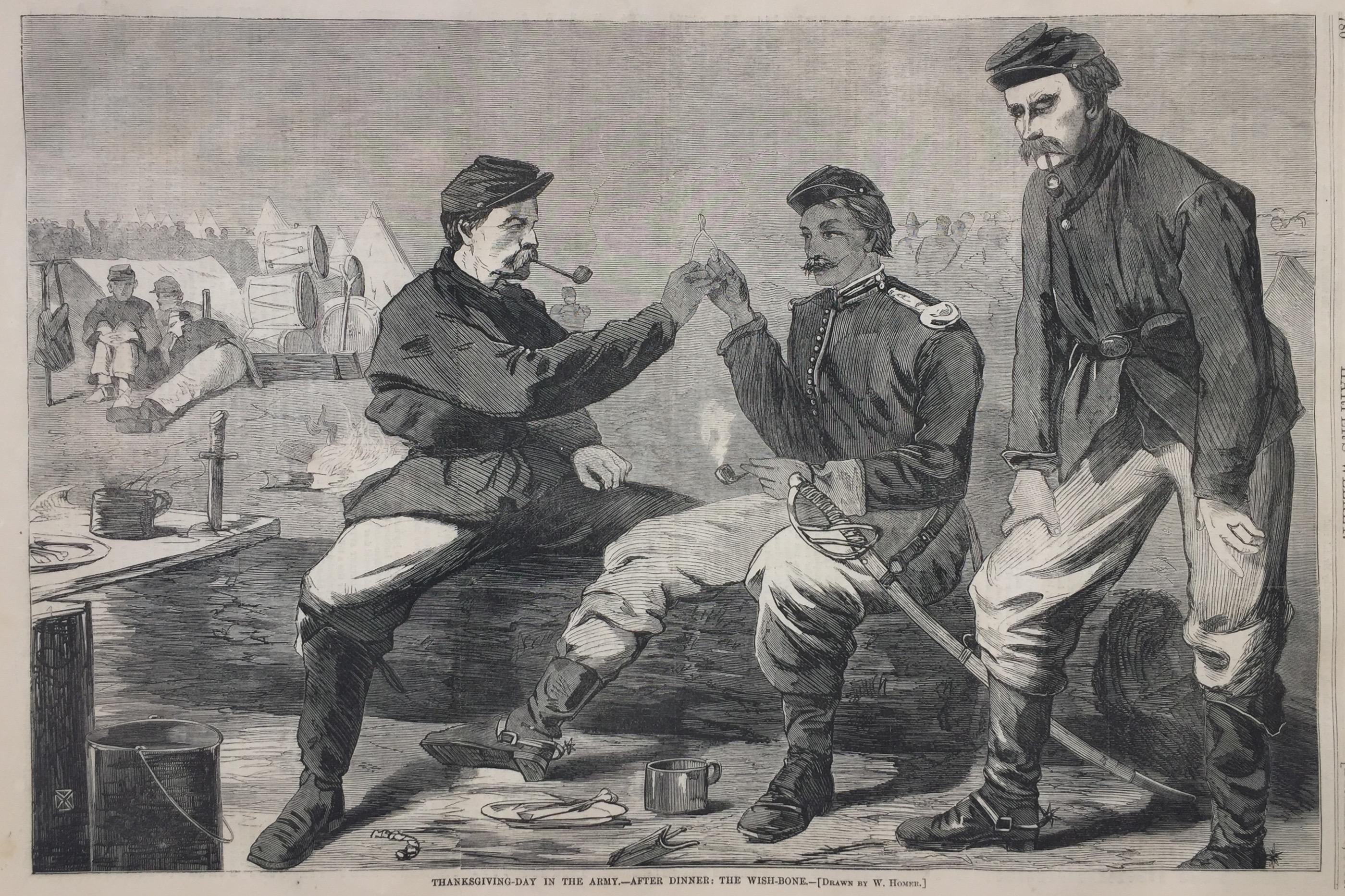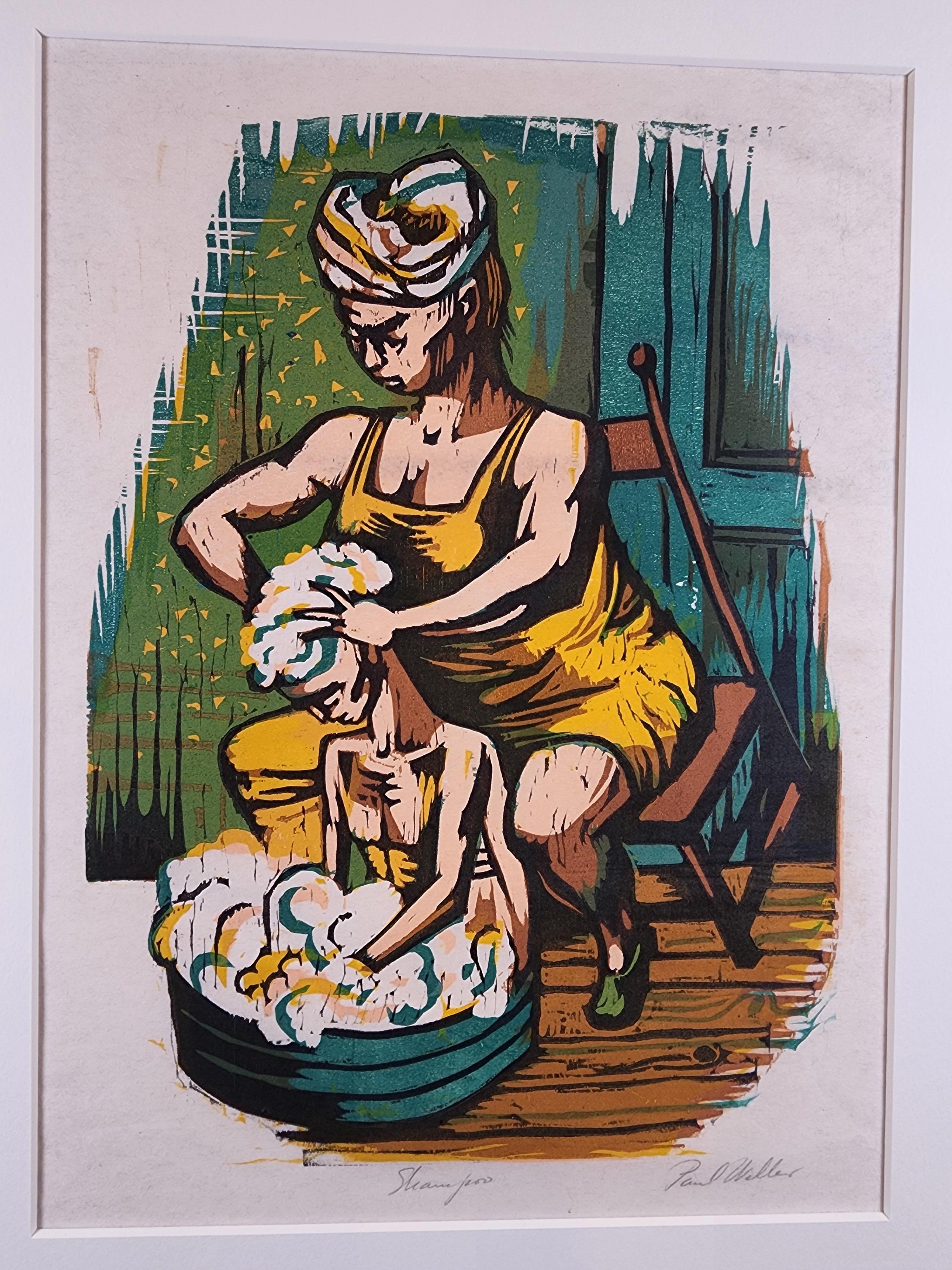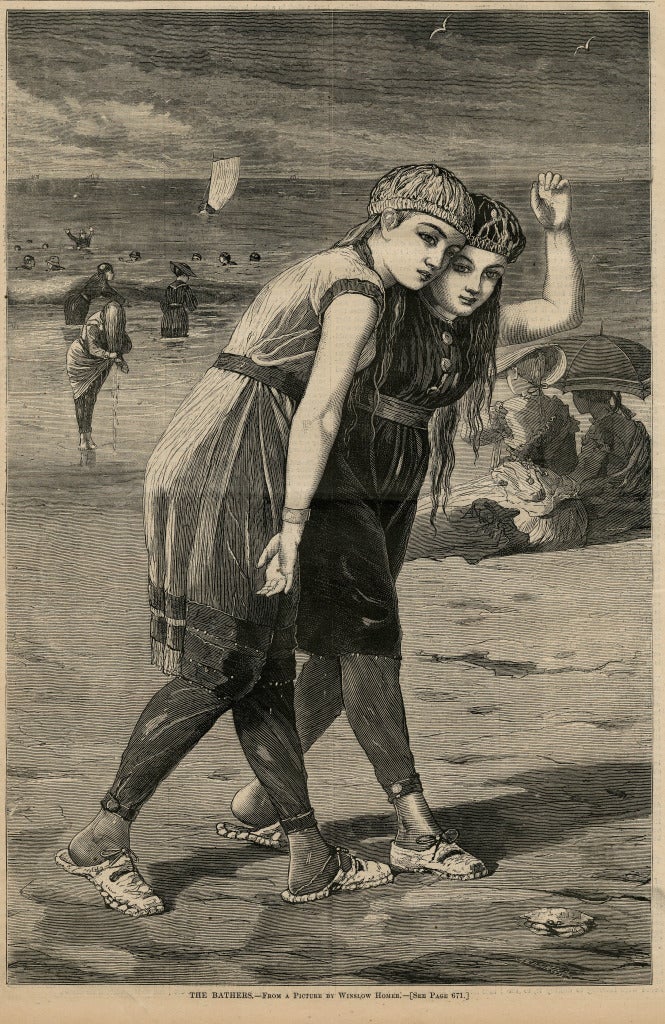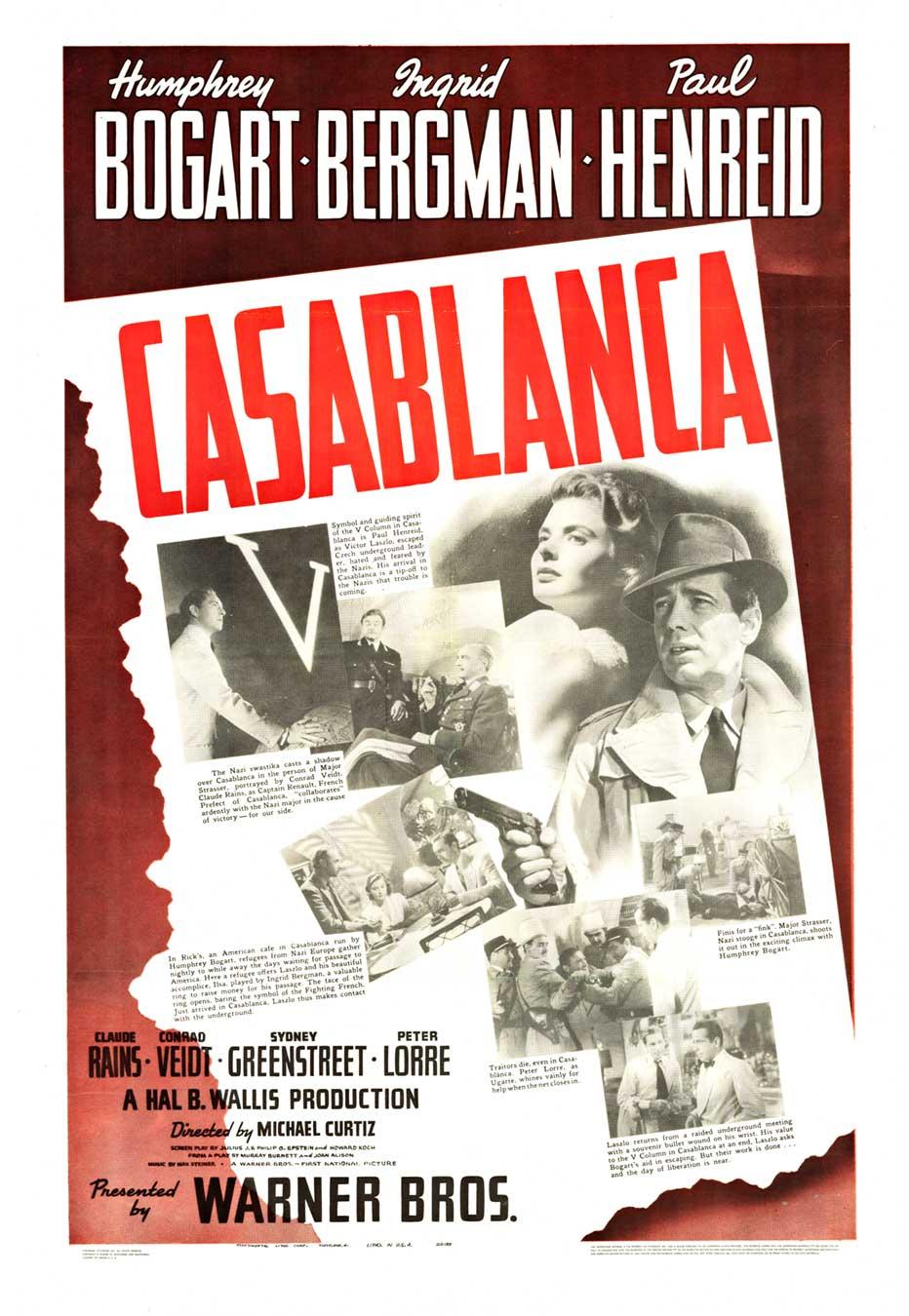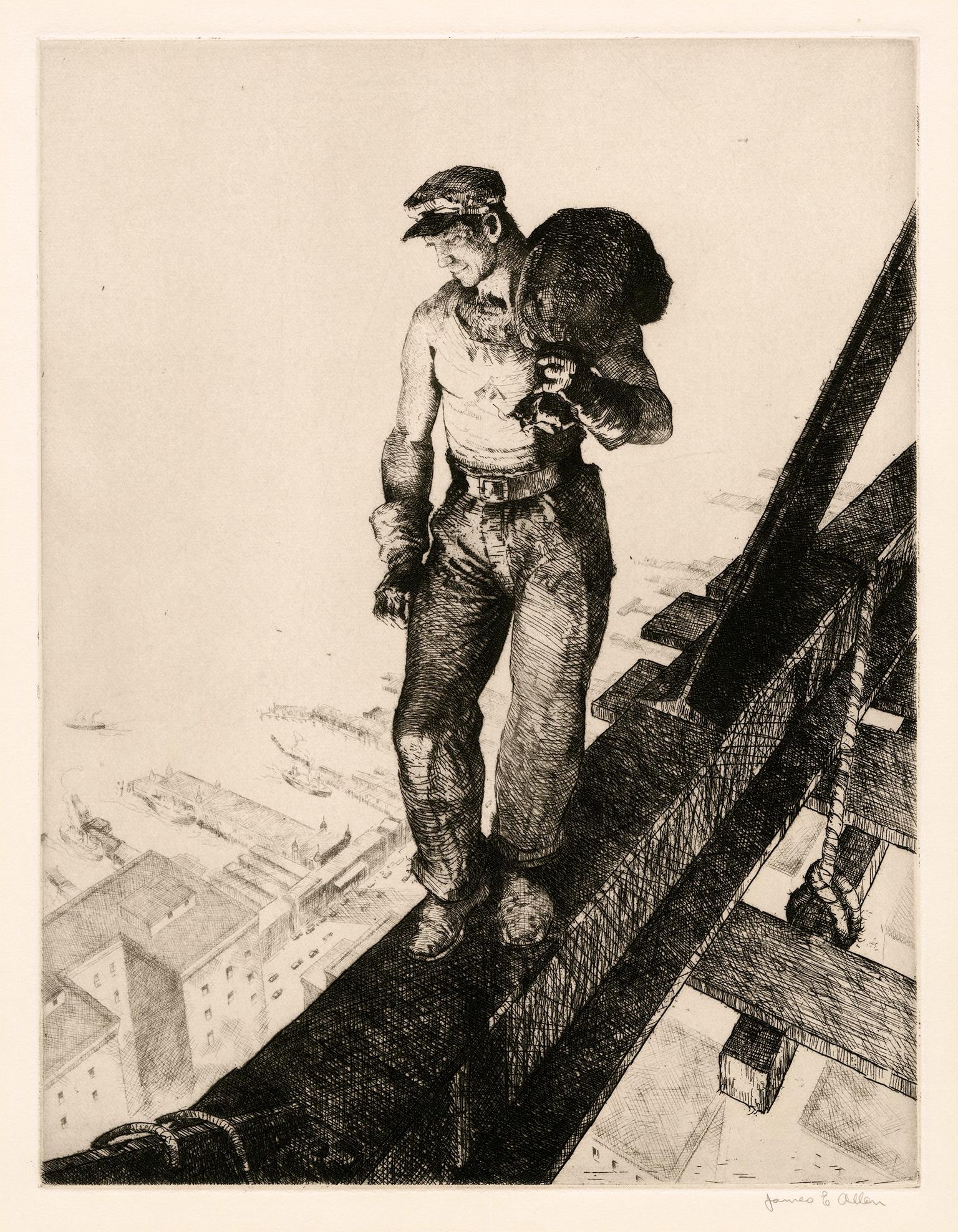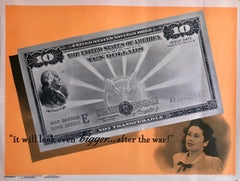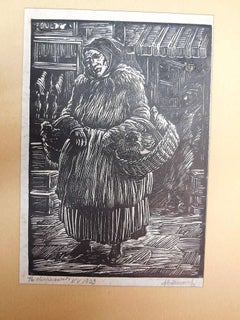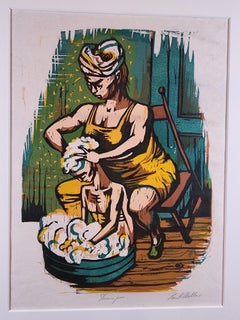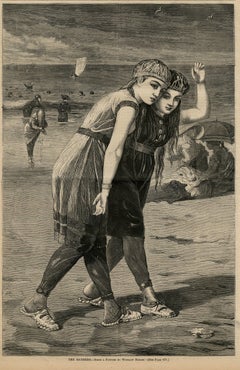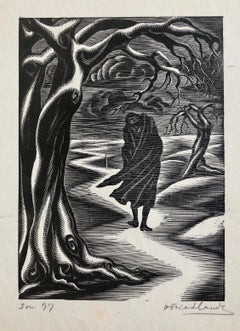
c.1930's WPA Jewish Artist Isaac Friedlander Woodcut Woodblock Art Deco Print
View Similar Items
Want more images or videos?
Request additional images or videos from the seller
1 of 8
Isaac Friedlanderc.1930's WPA Jewish Artist Isaac Friedlander Woodcut Woodblock Art Deco Print c.1930
c.1930
About the Item
- Creator:Isaac Friedlander (1890-1968, American)
- Creation Year:c.1930
- Dimensions:Height: 13.25 in (33.66 cm)Width: 10 in (25.4 cm)Depth: 1.5 in (3.81 cm)
- Medium:
- Movement & Style:
- Period:
- Condition:good. minor wear. please see photos.
- Gallery Location:Surfside, FL
- Reference Number:1stDibs: LU3824005601
About the Seller
4.9
Platinum Seller
These expertly vetted sellers are 1stDibs' most experienced sellers and are rated highest by our customers.
Established in 1995
1stDibs seller since 2014
1,549 sales on 1stDibs
Typical response time: 1 hour
More From This SellerView All
- Wpa Woman Laborer woodblock printBy Albert AbramovitzLocated in Surfside, FLoriginal limited edition woodcut woodblock print great depression era. (possibly a Moscow, Russia piece) signed in plate with monogram cipher mark. from the 1930s. Abramovitz, Albert 1879-1963 Born in Riga, Latvia, Abramovitz studied art at the Imperial Art School in Odessa and at the Grande Chaumière in Paris. In Paris, he became a member of the Salon in 1911 and in 1913 he became a member of its jury. He also became a member of the Salon d'Automne. While in Europe he received a medal at Clichy as well as the Grand Prize at the Universal Exhibition in Rome and Turin, Italy in 1911. In 1916, Abramovitz emigrated to America settling...Category
1930s American Realist Figurative Prints
MaterialsWoodcut
- Vintage Color WWII Poster "it will look even Bigger..." Offset LithographBy Franz Oswald SchiffersLocated in Surfside, FLThis is a vintage 1946 public service announcement poster The artwork is bold, clear and direct. "it will look even bigger… after the war!" Girl looks on longingly at 10 dollar bill....Category
1940s American Realist Figurative Prints
MaterialsOffset
- "the Chicken Vender" (or "Chicken Monger")By Albert AbramovitzLocated in Surfside, FLPencil signed original limited edition woodcut woodblock print great depression era. from the 1930s. Abramovitz, Albert 1879-1963 Born in Riga, Latvia, Abramovitz studied art at the Imperial Art Academy School in Odessa and at the Grande Chaumière in Paris. In Paris, he became a member of the Salon in 1911 and in 1913 he became a member of its jury. He also became a member of the Salon d'Automne. While in Europe he received a medal at Clichy as well as the Grand Prize at the Universal Exhibition in Rome and Turin, Italy in 1911. In 1916, Abramovitz emigrated to America settling...Category
1930s American Realist Figurative Prints
MaterialsPaper
- Social Realist Lithograph Moses Soyer WPA Artist Hudled RefugeesBy Moses SoyerLocated in Surfside, FLMoses Soyer (December 25, 1899 – September 3, 1974) was an American social realist painter. Soyer was born in Borisoglebsk, Russian Empire, in 1899. His father was a Hebrew scholar, writer and teacher. His family emigrated to the United States in 1912. Two of Soyer's brothers, Raphael (his identical twin) and Isaac were also painters. Soyer's wife, Ida, was a dancer, and dancers are a recurring subject in his paintings. Soyer studied art in New York, first at Cooper Union and later at the Ferrer Art School, where he studied under the Ashcan painters Robert Henri and George Bellows. He had his first solo exhibition in 1926 and began teaching art the following year at the Contemporary Art School and The New School. He died in the Chelsea Hotel in New York while painting dancer and choreographer Phoebe Neville. He was included in the show “American Modernism – Paintings from the Dr. and Mrs. Mark S. Kauffman Collection,” along with 30 leading masters of American modernism, which captured the essence of a revolutionary era...Category
Mid-20th Century American Realist Figurative Prints
MaterialsLithograph
- Artists Hand Signed and Inscribed "Ballet Dancers" Holiday Greeting CardBy Moses SoyerLocated in Surfside, FLThis piece a holiday card with hand painted print by the Social Realist artist Moses Soyer. Here, the artist depicts the figure of a dancer assuming different ballet poses and works in a very intimate scale, reflecting the delicate nature of ballet. Text on the piece reads: To Rina Moses Soyer (December 25, 1899 – September 3, 1974) was an American social realist painter. Soyer was born in Borisoglebsk, Russian Empire, in 1899. His father was a Hebrew scholar, writer and teacher. His family emigrated to the United States in 1912. Two of Soyer's brothers, Raphael (his identical twin) and Isaac were also painters. Soyer's wife, Ida, was a dancer, and dancers are a recurring subject in his paintings. Soyer studied art in New York, first at Cooper Union and later at the Ferrer Art School, where he studied under the Ashcan painters Robert Henri and George Bellows. He had his first solo exhibition in 1926 and began teaching art the following year at the Contemporary Art School and The New School. He died in the Chelsea Hotel in New York while painting dancer and choreographer Phoebe Neville. The Brooklyn Museum, the Detroit Institute of Arts, the Hirshhorn Museum and Sculpture Garden (Washington, DC), the Honolulu Museum of Art, the Metropolitan Museum of Art, the Museum of Modern Art (New York City), the Philadelphia Museum of Art, The Phillips Collection...Category
Mid-20th Century American Realist Figurative Prints
MaterialsScreen
- Girl in Ballerina Dress (Thonet Chair) Color Lithograph, American ModernistBy Philip PearlsteinLocated in Surfside, FLGirl in Ballerina Dress, c. 1970 Color lithograph printed on wove paper, hand signed in pencil and numbered 22/75, with the inkstamp of the publisher, Landfall Press, Chicago (they have published an eclectic list of many important artists including Christo, Judy Chicago, David Levinthal and Jack tworkov to name a few.) Philip Pearlstein is an influential American painter best known for Modernist Realism nudes. Cited by critics as the preeminent figure painter of the 1960s to 2000s, he led a revival in realist art. He is a Distinguished Professor Emeritus with paintings in the collections of over 70 public art museums. Philip M. Pearlstein was born on May 24, 1924 in Pittsburgh, PA. He attended Saturday morning classes at Pittsburgh's Carnegie Museum of Art. In 1942, at the age of 18, two of his paintings won a national competition sponsored by Scholastic Magazine, and were reproduced in color in Life magazine. In 1942, he enrolled at Carnegie Institute of Technology's art school, in Pittsburgh, where he painted two portraits of his parents now held by the Carnegie Museum of Art, but after one year he was drafted by the US Army to serve during World War II. He was initially assigned to the Training Aids Unit at Camp Blanding, Florida, where he produced charts, weapon assembly diagrams and signs. In this role, he learned printmaking and the screenprinting process, and subsequently was stationed in Italy making road signs. While in Italy, he took in as much renaissance art as was accessible in Rome, Florence, Venice and Milan, and also produced numerous drawings depicting life in the Army. In 1946, sponsored by the GI Bill, he returned to Carnegie Institute, and first met Andy Warhol, who was attracted to Pearlstein because of his notoriety in the school, having been featured in Life magazine. During the summer of 1947, the three rented a barn as a summer studio. Immediately after graduating in June 1949 with a BFA, Pearlstein and Warhol moved to New York City, at first sharing an eighth-floor walkup tenement apartment on St. Mark's Place at Avenue A. He was eventually hired by Czech designer Ladislav Sutnar, mainly doing industrial catalog work, while Warhol immediately found work illustrating department store catalogs presaging Pop Art. In April 1950, they moved to 323 W. 21st Street, into an apartment rented by Franziska Marie Boas, who ran a dance class on the other side of the room. During this time, Pearlstein painted a portrait of Warhol, now held by the Whitney Museum of American Art. In 1950, Philip Pearlstein married Dorothy Cantor, with Andy Warhol in the wedding party...Category
1970s American Realist Figurative Prints
MaterialsLithograph
You May Also Like
- THANKSGIVING IN CAMPBy Winslow HomerLocated in Santa Monica, CAAFTER - WINSLOW HOMER (1836-1910) THANKSGIVING IN THE ARMY - After Dinner: the Wishbone, 1864 Original wood engraving as published by Harpers Weekly December 3, 1864, after a drawing by Winslow Homer. Image 9 3/4" x 14, Sheet 10 3.\/4 x 15 3/4" . Generally good condition, a small stain in the upper right margin. Homer contributed drawings to Harper's Weekly from 1857 to 1875. They were converted to wood engravings by Harper's craftsman and published in Harper's Weekly. Although after his original drawings, they are now accepted as an important part of his body of work by museums and collectors. They were very large editions. As such, they occur often in the marketplace. Harper's published during the Civil War years as this was, were widely read and kept as people followed the war first hand and its aftermath over the years continuing today as both Homer and Civil War collectablesCategory
1860s American Realist Figurative Prints
MaterialsWoodcut
$175 Sale Price53% Off - ShampooLocated in Raleigh, NCRgrFineArts is pleased to offer this New York WPA color woodcut by Paul Weller titled Shampoo. The WPA label is affixed to the margin on the reverse of the print.Category
1940s American Realist Figurative Prints
MaterialsWoodcut
- The BathersBy Winslow HomerLocated in Fairlawn, OHThe Bathers Woodengraving, 1873 As published in Harper's Weekly, August 2, 1873 (p. 668) Provenance: Wunderlich & Co., Inc., New York, NY (Their stock no. ...Category
1870s American Realist Figurative Prints
MaterialsWoodcut
- Iris at DuskLocated in San Francisco, CAThis artwork titled "Iris at Dusk" 1980 is an original color woodblock print with embossing by American artist Daniel Joshua Goldstein, b.1950....Category
Late 20th Century American Realist Landscape Prints
MaterialsWoodcut
- TrumpeteersLocated in San Francisco, CAThis artwork titled "Trumpeteers" 1976 is an original wood engraving by Russian/American artist Leon Gilmour, 1907-1996. It is hand signed, titled, dated ...Category
Late 20th Century American Realist Figurative Prints
MaterialsWoodcut
- Tatoo-Shave-HaircutBy Reginald MarshLocated in New York, NYReginald Marsh (1898-1934), Tattoo-Shave-Haircut, etching, 1932. Signed, titled (“Tattoo-Haircut-Shave”), dedicated (“for Arnold Newman”), and annotated (“Fourth State. First of Two Prints”). Reference: Sasowsky 140. On cream wove paper. In very good condition, with small margins (as trimmed, slightly irregularly, by the artist) (slight foxing in margins), remains of prior hinging verso; 9 7/8 x 9 3/4, the sheet 10 15/16 x 10 5/8 inches; archival matting. A very fine rich black impression; we have not seen impressions of comparable quality on the market. Provenance: Estate of Arnold Newman. Arnold Newman (1918-2006) was one of the great 20th Century masters of photography, and a friend of many leading artists; it is appears that Marsh took special care in printing this impression for Newman. Sasowsky calls for 10 states of Tattoo-Shave, based largely on Marsh’s notes. But the states are not clearly delineated (e.g., his States 3 and 4, one proof each, are characterized by Marsh as “Engraving added”; no information is given for State 5). The design for the print was complete in the first state, and subsequent state changes were not, apparently, major. This impression does not appear to differ in etching lines from the final state impression shown in Sasowsky. Its inscription (as a Fourth State, by Marsh), as well as its rich inking and quality, attest to its being a proof before the edition (of about 34 impressions), but the state of this print (and, presumably of many of the other several proof impressions) cannot at this time be stated with confidence. Marsh printed this impression personally (we recall his famous answer to a question about the size of his editions: “Since I do practically all my own printing, I do not limit the edition. The buyer limits the edition – he rarely buys, I rarely print”). Tattoo-Shave-Haircut depicts a scene in the Bowery, a section of New York’s Lower East Side, during the Great Depression. The building and train structures in the top half of the print recall Piranesi’s Carceri...Category
1930s American Realist Figurative Prints
MaterialsEtching
Recently Viewed
View AllMore Ways To Browse
Art Deco Jewish
Jewish Etch
Russian Revival Style
Soviet Anti
1930s Woodblock
Art Deco Woodblock Print
Gilda Vintage
Rockwell Kent Woodcut
Art Deco Latvia
Isac Friedlander
Vintage African American Women
Mid Century Modern Abstract Head
Marc Chagall Original Painting
Picasso Lithograph 1954
English Painting 1930s
Green And Yellow Abstract Glass
Warhol Album Covers
Revolutionary War Paintings

